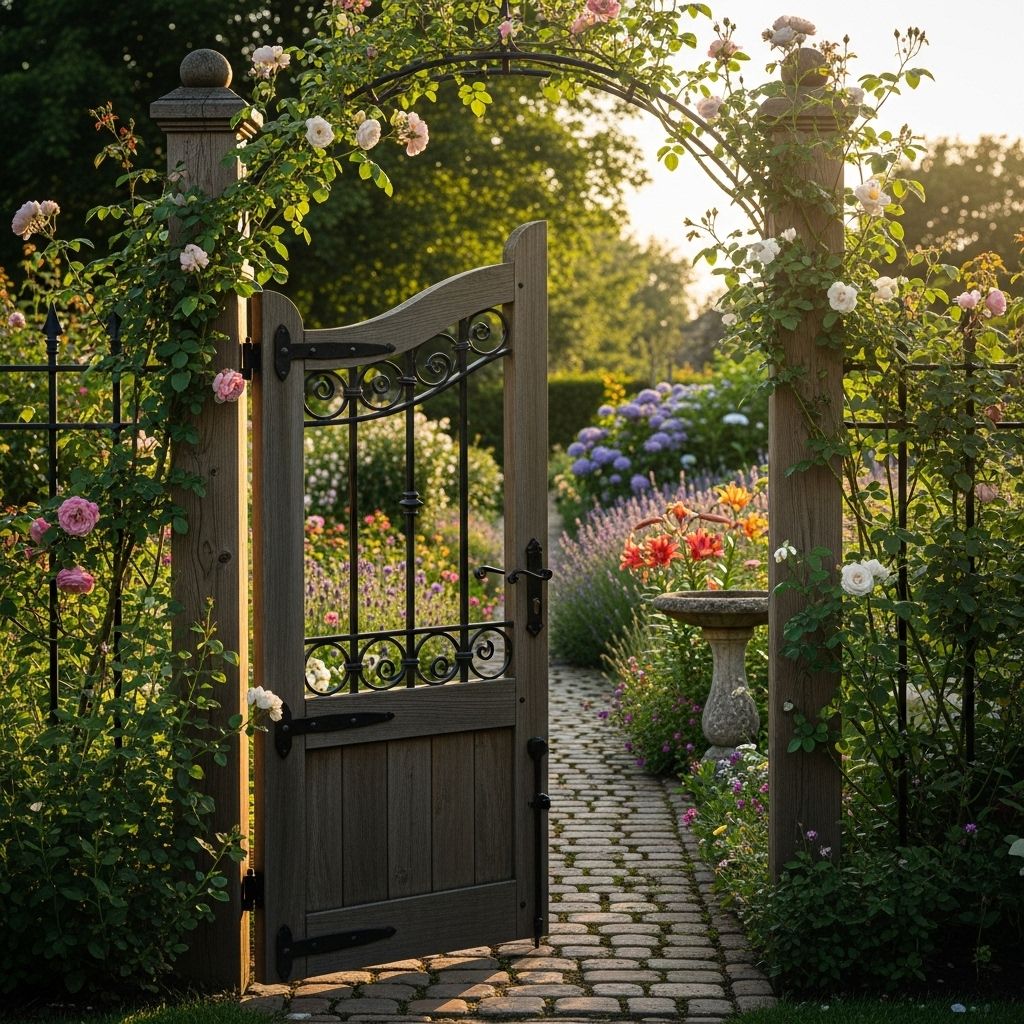Garden Gate Design Ideas: 5 Inspiring Styles For Your Yard
Discover how garden gates create transitions, mystery, and harmony in outdoor designs.

Image: HearthJunction Design Team
The Power of a Garden Portal
Garden portals aren’t merely entryways—they’re thresholds that redefine our perception of outdoor space. Whether grand or modest, visible or hidden, a well-placed gate or arbor marks a transition, inviting exploration, reflection, and a sense of anticipation. This article examines the various forms, functions, and design philosophies surrounding garden gates, and explores how these “portals” can utterly transform the mood and experience of a garden.
What is a Garden Portal?
A garden portal is any structure—a gate, arbor, arch, or covered entry—that signifies a passage from one area to another. Much like the rabbit hole in Alice in Wonderland, a portal in the garden can prompt curiosity and transport visitors into a unique world. These features are more than decorative; they orchestrate the flow, mood, and rhythm of the landscape.
- Significance: Garden portals symbolize transitions and new experiences.
- Design Impact: They punctuate the journey through your landscape, signaling movement from one garden room to another.
- Practical Benefits: Gates and thresholds can address practical concerns like privacy, security, and site drainage.
The Portal as Transition
Passing through a portal is a physical and emotional act. The very act of opening a garden gate—hearing its creak, feeling the resistance of the latch—creates a sense of expectation. It’s a tactile reminder that you’re leaving one environment for another. Elongating, accentuating, or framing the portal amplifies this sense of transition, making the destination feel special, even magical.
“A gate leads us from the known to the unknown. And, like that rabbit hole, if you elongate or accentuate the portal, it makes the transition even more tantalizing.”
Popular Garden Portal Styles
Garden portals come in many shapes and sizes, each offering distinct aesthetic and functional benefits. Here are a few classic styles:
- The Covered Gate
A covered gate, updated with durable roofing and fresh paint, is both practical and inviting. It visually anchors the entry, protects against weather, and can incorporate a stone or bluestone threshold. A well-designed threshold prevents soggy soil and welcomes visitors, while surrounding plantings such as Salix integra ‘Hakuro-nishiki’ (dappled willow) soften the scene and frame the entrance. - The Surprise Gate
Hidden or unexpected gates—especially those tucked among flowering shrubs—add whimsy and adventure. A latticed gate, for example, allows light and breeze to pass through and encourages visitors to explore further. Surprise gates act as secret passages, transforming even a small yard into a place of curiosity and delight. - The Rustic Arbor
Rustic arbors, constructed from natural wood or weathered materials, blend seamlessly with casual landscapes. These arbors often support climbing roses or vines, creating a living tapestry overhead. The interplay of sunlight and foliage above the path casts playful shadows and offers a sense of shelter and intimacy.
Main Elements of a Successful Garden Portal
- Solid Construction: Durable materials like wood, metal, or stone for longevity.
- Welcoming Threshold: Hardscape below the gate (bluestone, brick, or gravel) smooths transitions and handles foot traffic.
- Frame of Foliage: Plantings on either side of the portal help integrate the structure with its surroundings.
- Intrigue: Elongated approach paths, side plantings, or curved entryways add drama and invite exploration.
Psychological Impact: The Magic of Entry
Garden portals hold deep psychological resonance. Over centuries, gates and arches have symbolized beginnings, boundaries, and opportunities. In a landscape, passing through a portal can mark the shift from public to private, from busy to tranquil, or from order to wildness. This spatial storytelling enlivens the garden experience.
- Anticipation: Gates obscure full views, building suspense.
- Sense of Discovery: A hidden or ornamental gate beckons exploration.
- Framed Views: Portals act as picture frames, drawing the eye to focal points, sculptures, or distant vistas.
Functional Benefits of Garden Gates
Beyond their symbolic and aesthetic roles, garden portals are highly functional:
- Security & Privacy: Gates delineate boundaries and control access.
- Microclimate Management: Arbors or covered gates provide shade and wind shelter.
- Drainage Solutions: Stone or gravel thresholds help prevent soil compaction and waterlogging under the gate.
- Wildlife Corridors: Latticed or open gates let small animals and breezes pass through unobstructed.
Design Tips for Creating an Inviting Portal
- Choose the Right Location: Place gates at natural transitions—between front and back yards, lawn and woodland, or formal and informal areas.
- Frame with Plants: Use flowering shrubs, ornamental grasses, or small trees to draw attention to the gate.
- Scale and Proportion: Match the size of the portal to the surrounding space; a grand arch for a large garden, a petite gate for intimate corners.
- Materials: Select finishes that harmonize with your home and landscape style—wood for cottage gardens, wrought iron for formal settings, or recycled materials for an eclectic touch.
- Layer the Approach: Curved paths, staggered plantings, or stepping stones enhance the journey to and through the portal.
Inspiration: Types of Memorable Garden Gates
Let’s explore some standout examples and design ideas for garden gates and portals:
- Classic Wooden Gates: Painted or natural, these fit any style from picket fences to sophisticated estates.
- Metal Lattice Gates: Provide both transparency and security. Allow light and visibility without compromising privacy.
- Living Archways: Create portals using trained vines or espaliered trees for a lush, green entry.
- Stone Pillars with Iron Gates: A stately combination perfect for formal gardens or heritage properties.
- Hidden Fairy Gates: Small, whimsical doors nestled into hedges, perfect for children’s gardens and imaginative landscapes.
Impact on the Flow and Experience of a Garden
A garden portal controls not just access but mood and movement. The entry point sets expectations, and the design details guide visitors into and through the landscape. By fostering a sense of anticipation and discovery, portals transform gardens into narratives told through space and sequence. Whether it’s a lattice gate allowing breezes to flow or a dense arbor that opens into a secret garden, the effect is transformative.
| Portal Type | Best For | Key Benefit |
|---|---|---|
| Covered Gate | Entryways with heavy use | Weather protection, visual focus |
| Surprise Gate | Hidden corners, cottage gardens | Delight, curiosity, layered discovery |
| Rustic Arbor | Informal landscapes, wildlife gardens | Naturalistic beauty, living structure |
Latest Trends and Innovations
- Eco-Friendly Materials: Use of salvaged wood, recycled metals, and sustainable practices gaining momentum.
- Integrated Technology: Smart locks, app-controlled lighting, and automated gates for convenience and security.
- Multifunctional Structures: Portals doubling as support for edible vines, tool storage, or rainwater collection.
- Personalized Detailing: Custom metalwork, house numbers, and artistic motifs express individuality.
Frequently Asked Questions (FAQs)
Q: Why are garden portals important in landscape design?
A: They shape the journey through a garden, create focal points, mark transitions, and amplify the sense of arrival or discovery.
Q: What plants work best around garden gates?
A: Choose hardy, non-invasive plants that frame the portal without obstructing it. Flowering shrubs, dwarf conifers, and trained vines are popular choices.
Q: How do I choose between a solid and latticed gate?
A: Solid gates provide more privacy and security, while latticed gates offer openness and airflow. The choice depends on your goals for privacy, views, and style.
Q: Can a garden portal work in a small yard?
A: Yes! Scaled-down gates or arches can make even a tiny garden feel like an adventure, creating layers and visual interest.
Q: Are there maintenance concerns with garden gates?
A: Regular upkeep—tightening hinges, repainting, treating wood or metal for the elements—is essential to preserve both function and appearance.
Conclusion: Embracing the Power of Portals
Garden portals elevate everyday landscapes into experiences. They offer not just practical value, but psychological magic—turning a simple yard into a realm of invitation, curiosity, and surprise. Whether you’re designing a sprawling estate or a postage-stamp patio, consider the power of a well-placed gate or arbor: it may be the most memorable feature in your garden’s story.
References
- https://www.gardendesign.com/pictures/the-power-of-a-garden-portal_455/
- https://gardenersnorthwood.org.uk/blog/design-a-relaxing-portal-with-zen-garden-elements
- https://dubepropertymaintenance.com/online-landscape-design/
- https://duffieldtimber.com/the-workbench/timber-trends/garden-structures-features-design-ideas
- https://www.livingetc.com/advice/garden-features-that-add-value-to-a-home
Read full bio of Shinta












